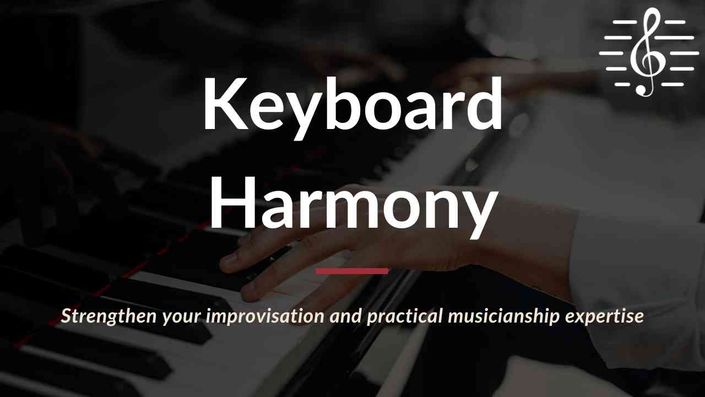
Keyboard Harmony
Strengthen your piano improvisation and practical musicianship expertise.
Enroll in Course
What You Will Learn
Master the fundamentals of harmony and apply them practically with the Keyboard Harmony course.
Many musicians want to develop their keyboard harmony skills, yet this is not easily achieved through text books. This course brings the topic to life by being completely practical, yet with the full theoretical aspects explained as required. This method encourages creativity by providing ideas for composing and musical expression. Chord dexterity and ear training are developed with focused keyboard exercises. You will develop accompaniment technique and improvisation skills with exercises that suit every level of harmonising experience. During the Keyboard Harmony course we'll cover...
- Basic Triads and Advanced Chords - How do you build chords in every major and minor key? How do you deal with inversions and more awkward chords? What are the ways you can improvise and incorporate more extended and chromatic chords?
- Rules of Harmony - How do you avoid the common traps of harmony? What are the best methods for improvising successful chord progressions? Which chords best progress onto which other chords?
- Melodic Material - How do you harmonise or improvise a melody over chords? What do you need to know about voice leading? What are the techniques you can use to fill space?
- Structure - How do you deal with modulation? When should you form a cadence? How do you come up with a strong chord progression and phrase structure?
- Musical Character - What are the stylistic elements you need to consider? What are the ways you can inject interest through the use of rhythm, dynamics, articulation and varied textures? How do you create a convincing piece of music?
I am an Organist in the Bishop Baughman United Methodist Church Freetown, Sierra Leone, West Africa. I've been watching your videos, especially those about harmony. I've learnt so much from you about harmony and I can now play and write hymns in four parts. May God bless you for sharing your gift with many.
- John

Who Is This Course For?
Aspiring improvisers and keen players.
The study of harmony is universally recognised as one of the basic disciplines in the musical education of a composer, performer and teacher. Understanding the theory behind harmony is important but being able to combine this knowledge on a practical level at the keyboard is a fantastic liberation. The keyboard harmony course is designed to develop both your theoretical knowledge of harmony and your practical application of harmony at the keyboard. Learning the skill of keyboard harmony is a huge benefit to musicians who strive to become real professionals.
Do any of these sound familiar?
"I just want to look at a melody and know exactly which chords to play with it..." "When I improvise I get stuck with the same old chords, I want to get more adventurous with harmony and modulation..." "I want to improvise easily in a way that sounds convincing and musical…" "I wish I had the ability to look at sheet music and instantly see the chords, harmony and progressions..." "I’m a composer and I want to develop greater facility to compose at the keyboard…"
↓
Fabulous as always. This is without a doubt one of the best music education sources on the net. Well done and thank you!
- Patrick

By the end of the Keyboard Harmony course you'll be able to…

Fluently improvise in a wide range of styles

Harmonise anything from the simplest song to advanced chromatic passages

Find diatonic chords in all inversions quickly under your fingers

Add musical character to your keyboard harmony through the use of rhythm, texture, articulation and dynamics

Deal with modulation and be confident about cadences and structure

Decide on the best chords and chord progressions to fit any melody
Wow! What a workout! But every sentence is important. As always, the presentation is absolutely top notch - logical and methodical, and perfectly summed up in the conclusion. You are the instructor I wish I had found years ago, but am thrilled to have right now.
- Paul

Course Information
What's Included with the Keyboard Harmony Course?
Professional Teaching
You'll receive expert training, thoroughly enabling you to develop the skill of keyboard harmony up to a professional level.
Practical Exercises
Each video teaches you the method for fluent harmony and then follows with a number of practical exercises for you to practice.
Ask Questions
Below each video you are able to post comments and ask questions should you have any in regards to the course topics covered.
Easy to Follow Structure
The course is divided into multiple stages, breaking down each part separately before putting it all together.
Complete at Your Own Pace
You can easily fit the course around your regular commitments, completing it at your own pace and in your own time.
Anywhere Access
Your course never expires. Learn when and where you choose! Computer or mobile. Just get comfortable and dive in!
↓
Your Instructor

Hi, I’m Gareth and I'm passionate about developing ‘the all round musician’.
Over 35 years of music examining with ABRSM, work with the BBC on Radio and TV, experience on the international concert platform, as a published composer and arranger, have brought rich resources to the 40 years of teaching in which I've engaged.
Scholarships at The Royal College of Music, Oxford University and St. Paul’s Cathedral gave me fantastic opportunities to learn from the best musicians, scholars and teachers. Working as Director of Music at Queen Elizabeth Grammar School then provided a wonderful opportunity to develop my teaching skills.
Teaching individuals and groups of all ages, and at all stages of development have refined a teaching approach that I hope is fun and engaging, and focused on explaining things clearly and logically. And that is what these courses are all about - understanding the basic principles with clarity, then going deeper, applying them to your musical life and liberating yourself as a musician.
It’s a rich and amazing journey, and I can’t wait for you to join me today!
Course Curriculum
-
PreviewLesson 1 - An Introduction to Keyboard Harmony (3:01)
-
StartLesson 2 - Chords in C, G and F Major (21:26)
-
StartLesson 3 - Converting Primary Triads into Chords (15:27)
-
StartLesson 4 - Basic Chord Progressions in Major Keys (19:15)
-
StartLesson 5 - Adding Chords II and VI in Major Keys (20:37)
-
StartLesson 6 - Cadences in Major Keys (15:04)
-
PreviewLesson 7 - Some Things to Avoid (14:49)
-
StartLesson 8 - Melodies and Chords 1 (19:48)
-
StartLesson 9 - Melodies and Chords 2 (6:29)
-
StartLesson 10 - The Next Stage of Keyboard Harmony (1:28)
-
StartLesson 11 - Inversion Chords, Second Inversions and Using Chord VII (28:29)
-
StartLesson 12 - Chords in Am, Em and Dm (23:30)
-
StartLesson 13 - Basic Chord Progressions in Minor Keys (15:24)
-
StartLesson 14 - Cadences in Minor Keys (8:34)
-
StartLesson 15 - Melodies Ending with Cadences (10:23)
-
StartLesson 16 - Harmonising Whole Melodies in Major Keys (22:34)
-
StartLesson 17 - Harmonising Whole Melodies in Minor Keys (20:26)
-
StartLesson 18 - Advanced Keyboard Harmony (1:39)
-
PreviewLesson 19 - Improvising Melodic Material Over Harmony (17:05)
-
StartLesson 20 - Pivot Chords and Modulation (15:30)
-
StartLesson 21 - Extended Chords (15:42)
-
StartLesson 22 - Diminished 7th Chords (7:16)
-
StartLesson 23 - Neapolitan Chords (6:34)
-
StartLesson 24 - Augmented 6th Chords (8:22)
-
StartLesson 25 - Dealing in More Advanced Keys (9:42)
-
StartLesson 26 - Integrating Musical Character (9:11)
Frequently Asked Questions
A Letter from Gareth Green
MA (Oxon), MA (Leeds), FRCO(CHM), FLCM, ARCM
Over the years I’ve taught many people who have proficient keyboard skills, some of whom can perform repertoire at an impressive level. Yet, when it comes to Sight Reading, Aural skills, and/ or keyboard harmony skills they are struggling.
By working at keyboard harmony many have been pleasantly surprised that not only can they improvise and harmonise melodies but that this also vastly improves their ability to Sight Read and to tackle Aural skills. These threads are indeed very closely related and integral to anyone seeking to be an all-round musician.
I was so lucky that during my formative years musically I was a church organist. Very quickly I had to learn to improvise because brides arrived late for weddings or the collection was still being taken when the hymn had finished or the Priest was clearing up at the end of distributing Communion. My early attempts were uncertain but as the years passed I became more confident. These improvisations started to include cadences, modulations, more colourful chords, more interesting melodic design, greater counterpoint, and variety of musical styles. I’m absolutely convinced that this regular development of keyboard harmony made Aural work and Aural Dictation much easier for me, it made written harmony seem like a natural extend of keyboard harmony, and it made Sight Reading easier - all because the keyboard harmony enabled me to hear everything that was sounding or that was written down.
Whether you’re a so-called “Classical” musician, or a jazzer, or play in a band, if you’re a keyboard player, keyboard harmony is central to developing all these associated skills. If you’re a composer keyboard harmony skills are a real lifeline.
Those early skills have served me well throughout my musical life. Now I want to share all that with you so you can experience that musical liberation too. This is what lies at the heart of our keyboard harmony course.
— Gareth Green, Music Matters




